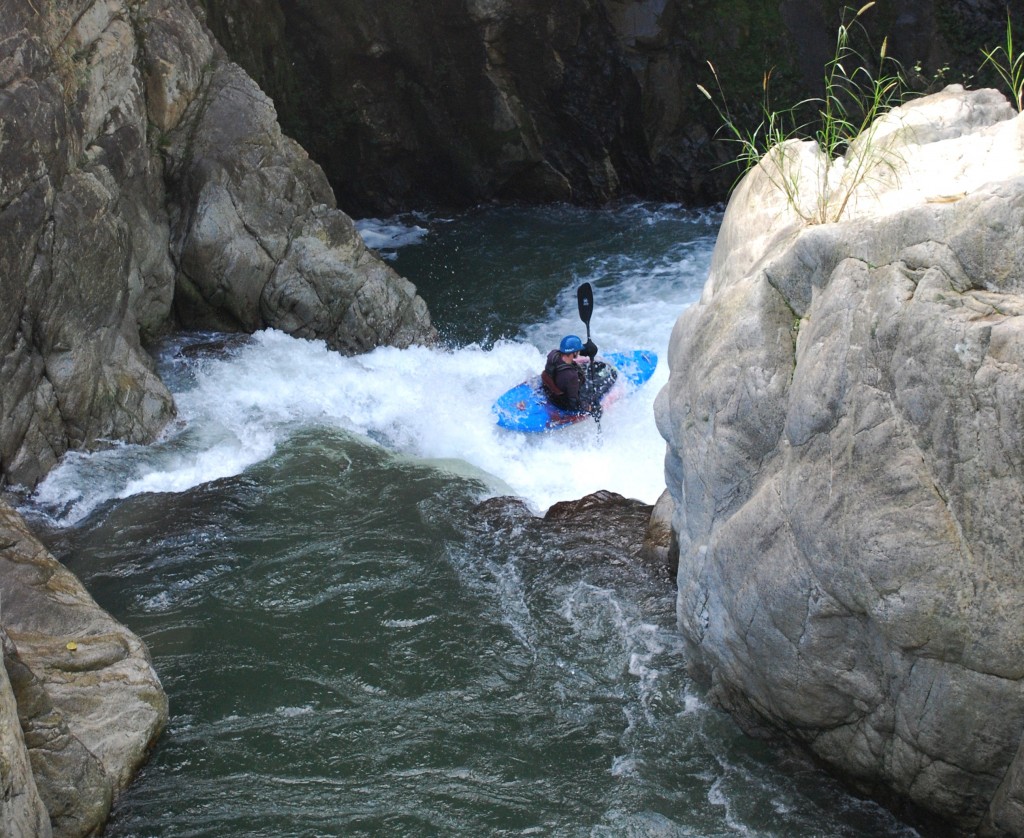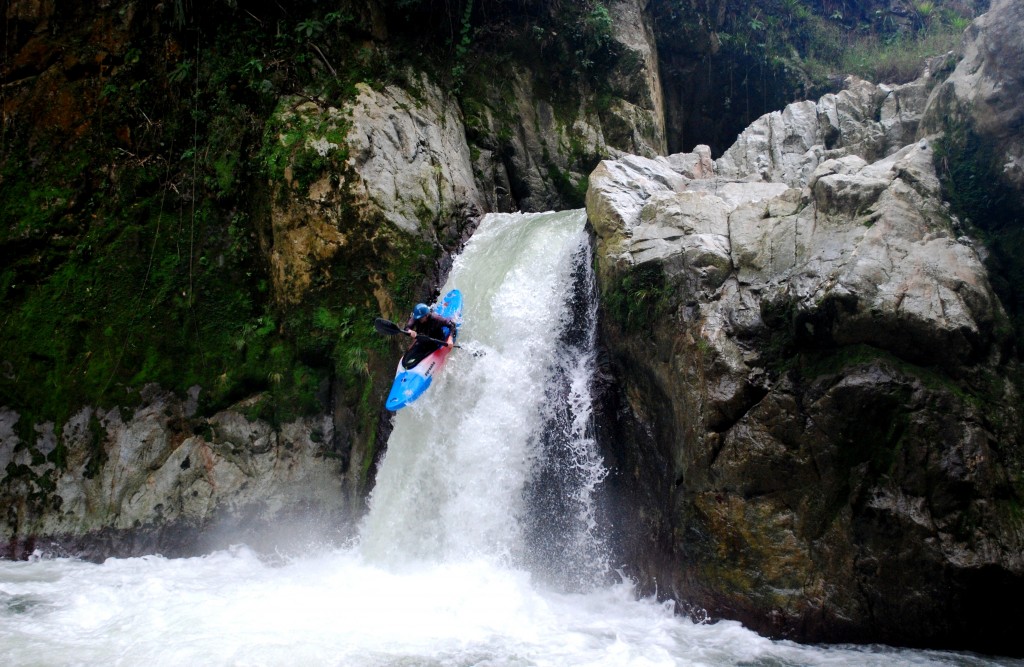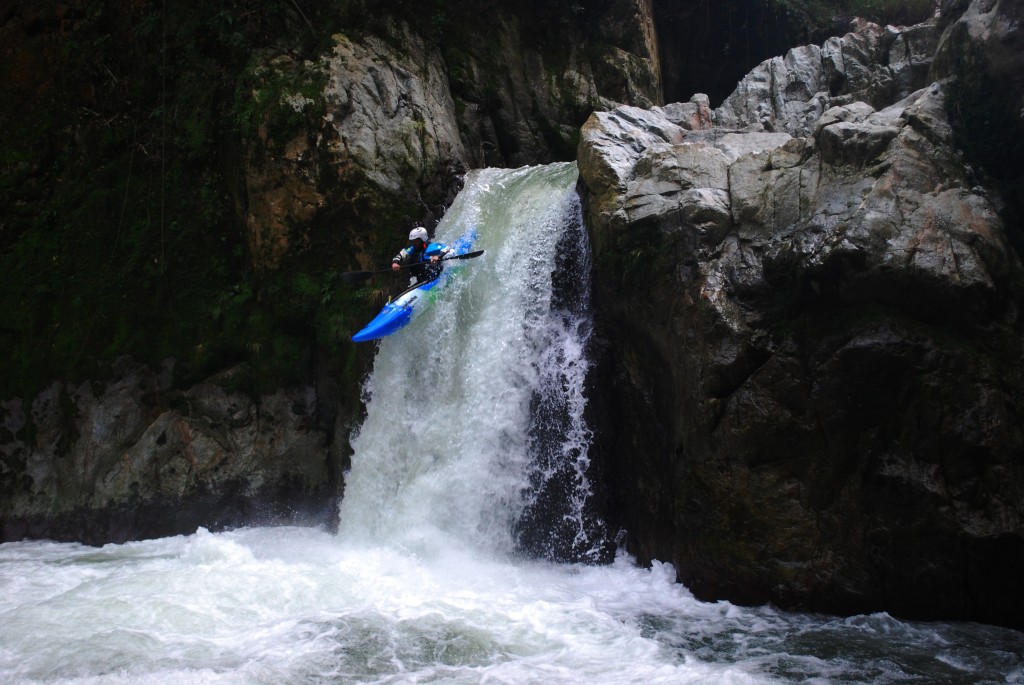In December of 2015 Matthew Beauchamp, Steve Krajewski, Shannon Goshorn, and I headed to the island of Hispaniola to check out the rivers of the Dominican Republic. Although the island was experiencing a pattern of dry weather, we still found options to paddle daily and enjoyed a great time in this lesser known paddling destination. If you missed the previous parts of our trip report, you can find Part I: Rio Yaque del Norte HERE, Part II: Rio Blanco HERE, and Part III: Upper Rio Jimenoa HERE.
Below: Matthew Beauchamp on the perfect waterfall. Photo by Adam Goshorn.

The Upper Rio Jimenoa ends at a swinging bridge over the river that is also the put-in for the Staircase Section. The Staircase Section is named for its take-out, which involves climbing 900 concrete steps up and out of the canyon. The steps are in place as a result of a dam, completed in 1950, which was the first hydroelectric project in the Dominican Repbulic. Operators at the dam work in 24-hour shifts and commute via the same steep staircase that allows paddlers to exit the canyon at the end of their run. It can also be said that the name of the Staircase Section has a double meaning because the riverbed loses gradient in bedrock steps throughout the run. Not far from the swinging bridge at the put-in the river enters a bedrock canyon that doesn’t let up for the rest of the run. With lots of blind drops and the bedrock canyon making scouting and portaging very time consuming, it took us most of the day to scout our way down this amazing run.
Below: Steve Krajewski on one of the early drops. Photo by Adam Goshorn.

At one point in the run we came to a two-part drop that consisted of a rapid, leading into a hallway with overhanging walls, that then spouted off a waterfall into the pool below. The problem was, a log made the entrance rapid look less than appealing. We spent some time scrambling around and scouting various options. I decided to portage, while Matt and Steve decided they would seal-launch into the hallway and run the second drop. After further examination of the portage options produced no feasible portage routes, I eventually resigned myself to having to throw-and-go from the much higher cliff to the right of the final spout. A quick swim to the bank had me back in my boat and we were back on the move heading downstream.
Below: Steve Krajewski on another one of the early drops. Photo by Adam Goshorn.

The whole section was pretty great, but I think the other guys would agree that the true highlight of the run was a beautiful, picturesque, drop that came about three-quarters of the way into the run. After a really tight part of the canyon, we found a tricky-looking entrance rapid leading into the perfect waterfall. Luckily the entrance rapid was easily skipped with a small seal-launch about ten feet upstream of the lip of the falls. One by one we sailed off the falls… reaping the reward for the day’s efforts; this was what we came for!
Below: Adam Goshorn on the highlight drop. Photo by Steve Krajewski.

After the waterfall, we knew we needed to proceed with extra caution. One of the pioneers of Dominican Republic whitewater, Dag Grada, had told us that there was an unrunnable waterfall near the end of the run that would be terrible to blunder into accidently. With that in mind, we rounded the corner, ran a small ledge, and then portaged an ugly boulder jumble. The next rapid consisted of three slots, none of which looked particularly appealing at the current water level, so we portaged high on river right and lowered boats back to river level. At this point we could see a horizon line, that we assumed was the unrunnable drop and an eddy twenty feet above the lip on the right. However, it was hard to tell how swift the current was leading up to the eddy, so back up the right side we went, portaging high once again. To get back to river level, we put a sling around a tree and lowered Steve’s boat down to the bedrock shelf above the mandatory portage. Steve climbed down, unhooked the boat, and sent it back up to Matt and I. After sending my boat down, we were in the process of hooking Matt’s boat into the rope when we saw my boat floating downriver towards the horizon line. We could see Steve scrambling to try to grab my boat, but there was no way to do so and we watched as it went over the lip and heard it a loud bang from the canyon below.
Below: Steve Krajewski spotting his landing. Photo by Adam Goshorn

We hurriedly lowered Matt’s boat, scrambled down to river level, and made our way to a pothole where the other guys could seal launch into the canyon below the drop. Matt went first and took off around the corner to try to catch up to my boat. I held Steve’s boat while he seal launched and then I jumped into the canyon myself. Holding onto the back of Steve’s boat and kicking, while he paddled, we headed downstream, hoping for good news. Luckily, the river was almost flat at this point and after a couple of curves in the river Matt came back upstream towing my boat. Unbeknownst to us (and incredibly luckily), we had entered the backwaters of the narrow lake formed by the dam at the take-out. Matt had been able to catch up to my boat fairly easily and had even recovered by camera bag and both elbow pads! Reunited with all of my gear, we hammered out the remaining quarter-mile of flat water to the take-out where Shannon and Jose Manual were waiting. By the time we reached the top of the namesake staircase, it was almost dark. Thankfully, all that was left to do at that point was to head back into Jarabacoa in search of food and beer.
Below: Video from our run down the Staircase Section of the Rio Jimenoa. It doesn’t include all the rapids, but the ones it does include are shown in order. Edited by Adam Goshorn.
Until next time…
Adam Goshorn
Below: Matthew Beauchamp lowering the landing gear. Photo by Adam Goshorn




